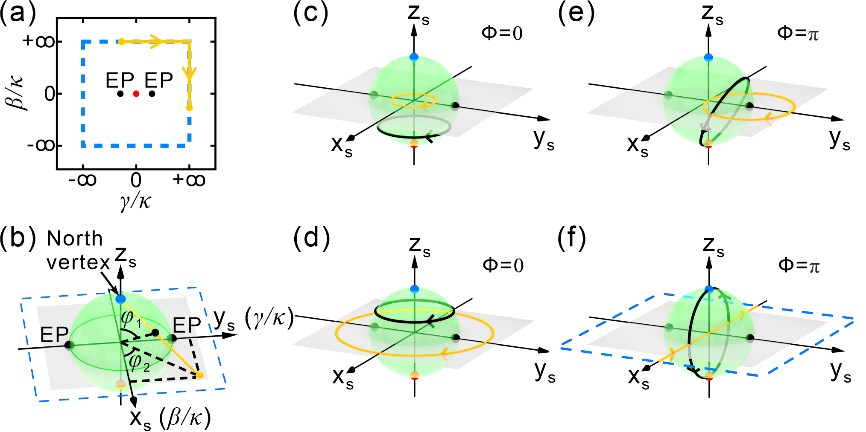On September 13, Prof. Lin Chen from Wuhan National Laboratory for Optoelectronics, Huazhong University of Science and Technology published new advances in PHYSICAL REVIEW LETTERS. The paper is entitled Riemann-encircling exceptional points for efficient asymmetric polarization-locked devices.
Non-Hermitian physics, one of the most active branches of modern physics, is playing a key role for widespread applications. Among many intriguing effects, exceptional points (EPs) in a non-Hermitian system has inspired extensive research interest recently. Two or more eigenvalues and eigenstates are simultaneously degenerate at EPs and such uniquephenomena has inspired the research and applications in optical systems, such as high sensitivity sensing and mode control.
Controlling optical mode is a topic of concern, and different modes can carry different signals in optical communication, which is conducive to improving communication capacity. Asymmetric transition of optical modes can be realized by constructing an evolution path that encircles EPs in the Hamiltonian parameter space composed of loss difference and coupling detuning. Different optical modes output for different transmission directions even when the input mode is the same. However, most of the previous studies only regulate the modes with the same polarization direction, and the transmission efficiency is low. Efficient asymmetric transmission for different polarization modes has not been realized to date.
In 2020, Lin Chen's team has realized high efficient asymmetric mode transmission by constructing an encircling-EP loop that passing through the infinite boundary of 2D parametric space. In the latest research, they mapped the 2D parameter space onto a closed manifold of Riemann sphere, in which the infinite parameter space boundary with convergent eigenstates converges to the north vertex (Fig. 1). The encircling-EP loop passing through the infinite boundary is clearly displayed on the Riemann sphere, and a framework to describe the topological equivalence of encircling-EP loops is provided.

Figure 1. Encircling EPs on the Riemann sphere
The development of silicon waveguides with various functions on chips has promoted the development of optical communications. Benefitting from the Riemann sphere mapping, we can encircle an EP along a continuous and closed trajectory passing through the north vertex and achieve highly-efficient asymmetric transmission. Experimental results have been presented by mapping this trajectory onto L-shaped waveguides, demonstrating near-unity asymmetric conversion efficiency at 1550 nm (Fig. 2). Such a functionality corresponds to an asymmetric polarization-locked device, since the output polarization state is locked irrespective of the input polarization states. The output mode is locked to TE for a left-side input, and is locked to TM for a right-side excitation. The mode crosstalks TM→TE, TM←TE, and TE→TE are all below -20dB, while TM←TM is below -10dB at telecommunication wavelengths.

Figure 2. The asymmetric polarization-locked device
This work provides a new view for studying topological properties related to EPs by constructing a theoretical framework of encircling loop on the Riemann sphere. Highly efficientasymmetric polarization-locked deviceis realized by mapping the encircling-EP loop onto L-shaped waveguides, which enriches the method of regulating optical mode on chip and brings new opportunities for non-Hermitian optical applications.
Paper link:
https://journals.aps.org/prl/abstract/10.1103/PhysRevLett.129.127401